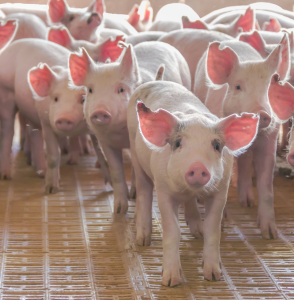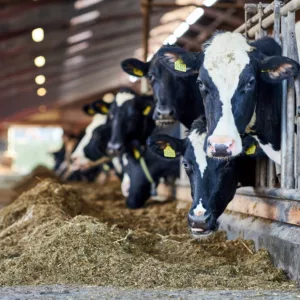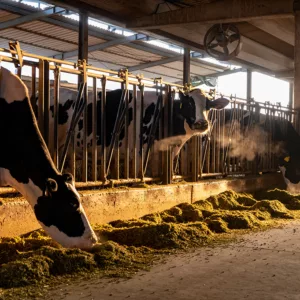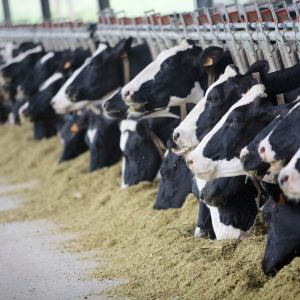The health status of swineherds has significant implications on animal welfare and production efficiency, including growth rate, feed conversion, and profitability. Therefore, swine producers and veterinarians work daily to improve and maintain the health of their herd through critical biosecurity practices. There are many definitions of biosecurity. Simply put, biosecurity is practices implemented to prevent the introduction or prevent the further spread of pathogens capable of causing disease.

The classic form of biosecurity is bioexclusion – practices put into place to prevent the introduction of pathogens into a farm or population of animals from an outside source. Standard bioexclusion methods include downtime for personnel entering the facility, cross-over entry benches, and shower-in shower-out procedures. Another concept of biosecurity often overlooked is biocontainment. Biocontainment
is the concept of keeping pathogens from spreading off a farm and to other facilities or even preventing spread with groups of animals within a single farm. Both bioexclusion and biocontainment are necessary to consider when developing a biosecurity program. A successful biosecurity program has several key components. First and foremost, for any plan to be successful, the organization must embrace a culture of biosecurity which includes consistent expectations and accountability at all levels of the organization. If an organization lacks an appropriate biosecurity culture, it is difficult to consistently implement the plan as a whole, which can lead to an undesirable level of success. A second key component of biosecurity is the training of employees with a specific focus on WHY the procedures are essential and HOW those practices can maintain the high herd health of the animals they are involved in raising. Furthermore, biosecurity generally requires additional time, effort, and expense compared to no biosecurity measures. Thus, resources and protocols are necessary to simplify the biosecurity process. Proper infrastructure is also vital for employees to implement any biosecurity program. Features that help employees perform the daily tasks in a more biosecure way dramatically increase the success of these practices. The final component of a biosecurity program is continuous improvement and resources, such as routine audits and diagnostic testing. These programs can help identify potential inconsistencies within a biosecurity program before there is a problem. Biosecurity advances in the swine industry have been abundant in recent decades, greatly expanding our knowledge of infectious disease transmissions such as PRRSV, PEDV, and other common diseases. By pinpointing the most common risks of diseases transmission, swine producers have put practices into place to further improve against infectious diseases. One of the most common risks emphasized in biosecurity research is the movement of people, animals, and fomites, within the swine production system (Gebhardt et al., 2021; Greiner, 2016). Several practices have helped control these biosecurity risks, such as limiting farm visitors, using farm sign-in books, documenting animal movements, and on-farm sanitation. Most farms also are supplied with facility-only clothing and tools necessary for daily tasks, minimizing, cross-contamination from outside the farm. In addition, equipment like autoclaves and sterilizers are becoming more common at farm entrances to reduce the risk of pathogen entry through supplies and equipment brought onto the farm. Air filtration units are also being installed on most swine farms, minimizing the risk of virus introduction through aerosol particles. Production facilities with multiple locations and ones that practice an all-in-all-out approach are also essential to reducing prevalences of growth-suppressing disease. Multi-site production systems are standard in commercial swine production, where breeding, gestation, and farrowing are separate from the other production phases. Separating the different stages of production minimizes newborn piglets’ exposure to infectious agents that may decrease their growth performance down the line. These facilities also usually follow an all-in-all-out protocol when moving animals between farms or rooms. By transporting pigs of similar age, weight, and production stage, farmers can further reduce disease transmission, improve management, and provide better environmental control. With these advances, knowledge is available regarding best practices for farm implementation (Levis and Baker, 2011; FAO, 2010). While many of these concepts are relatively intuitive and have been around for some time, consistent implementation remains a challenge, and we continue to face difficulties to swine health daily. Biosecurity is always ongoing and contains a series of hurdles; there is no silver bullet. However, organizations can continue developing and refining their programs by focusing on the four fundamental concepts of swine biosecurity. The four concepts: 1) culture, 2) training, 3) infrastructure, and 4) continuous improvement are critical components of a successful biosecurity program in swine production.
is the concept of keeping pathogens from spreading off a farm and to other facilities or even preventing spread with groups of animals within a single farm. Both bioexclusion and biocontainment are necessary to consider when developing a biosecurity program. A successful biosecurity program has several key components. First and foremost, for any plan to be successful, the organization must embrace a culture of biosecurity which includes consistent expectations and accountability at all levels of the organization. If an organization lacks an appropriate biosecurity culture, it is difficult to consistently implement the plan as a whole, which can lead to an undesirable level of success. A second key component of biosecurity is the training of employees with a specific focus on WHY the procedures are essential and HOW those practices can maintain the high herd health of the animals they are involved in raising. Furthermore, biosecurity generally requires additional time, effort, and expense compared to no biosecurity measures. Thus, resources and protocols are necessary to simplify the biosecurity process. Proper infrastructure is also vital for employees to implement any biosecurity program. Features that help employees perform the daily tasks in a more biosecure way dramatically increase the success of these practices. The final component of a biosecurity program is continuous improvement and resources, such as routine audits and diagnostic testing. These programs can help identify potential inconsistencies within a biosecurity program before there is a problem. Biosecurity advances in the swine industry have been abundant in recent decades, greatly expanding our knowledge of infectious disease transmissions such as PRRSV, PEDV, and other common diseases. By pinpointing the most common risks of diseases transmission, swine producers have put practices into place to further improve against infectious diseases. One of the most common risks emphasized in biosecurity research is the movement of people, animals, and fomites, within the swine production system (Gebhardt et al., 2021; Greiner, 2016). Several practices have helped control these biosecurity risks, such as limiting farm visitors, using farm sign-in books, documenting animal movements, and on-farm sanitation. Most farms also are supplied with facility-only clothing and tools necessary for daily tasks, minimizing, cross-contamination from outside the farm. In addition, equipment like autoclaves and sterilizers are becoming more common at farm entrances to reduce the risk of pathogen entry through supplies and equipment brought onto the farm. Air filtration units are also being installed on most swine farms, minimizing the risk of virus introduction through aerosol particles. Production facilities with multiple locations and ones that practice an all-in-all-out approach are also essential to reducing prevalences of growth-suppressing disease. Multi-site production systems are standard in commercial swine production, where breeding, gestation, and farrowing are separate from the other production phases. Separating the different stages of production minimizes newborn piglets’ exposure to infectious agents that may decrease their growth performance down the line. These facilities also usually follow an all-in-all-out protocol when moving animals between farms or rooms. By transporting pigs of similar age, weight, and production stage, farmers can further reduce disease transmission, improve management, and provide better environmental control. With these advances, knowledge is available regarding best practices for farm implementation (Levis and Baker, 2011; FAO, 2010). While many of these concepts are relatively intuitive and have been around for some time, consistent implementation remains a challenge, and we continue to face difficulties to swine health daily. Biosecurity is always ongoing and contains a series of hurdles; there is no silver bullet. However, organizations can continue developing and refining their programs by focusing on the four fundamental concepts of swine biosecurity. The four concepts: 1) culture, 2) training, 3) infrastructure, and 4) continuous improvement are critical components of a successful biosecurity program in swine production.
References
Food and Agriculture Organization of the United Nations/World Organisation for Animal Health/World Bank. 2010. Good practices for biosecurity in the pig sector – Issues and options in developing and transition countries. FAO Animal Production and Health Paper No. 169. Rome, FAO. http://www.fao.org/3/
i1435e/i1435e.pdf. Gebhardt, J.T., Dritz, S.S., Elijah, C.G., Jones, C.K., Paulk, C.B., and Woodworth, J.C. 2021. Sampling and detection of African swine fever virus within a feed manufacturing and swine production system. Transbound. Emerg. Dis. DOI: 10.1111/tbed.14335. Greiner, L.L. Evaluation of the likelihood of detection of porcine epidemic diarrhea virus or porcine delta coronavirus ribonucleic acid in areas within feed mills. J Swine Health Prod. 2016. 24(4):198-204. https://www.aasv.org/shap/
issues/v24n4/v24n4p198.html Levis, D.G., and Baker, R.B. 2011. Biosecurity of pigs and farm security. University of Nebraska, Lincoln. https://www.porkgateway.org
/wp-content/uploads/2015/07/|
biosecurity-of-pigs-and-farm-secuiryt.pdf.
i1435e/i1435e.pdf. Gebhardt, J.T., Dritz, S.S., Elijah, C.G., Jones, C.K., Paulk, C.B., and Woodworth, J.C. 2021. Sampling and detection of African swine fever virus within a feed manufacturing and swine production system. Transbound. Emerg. Dis. DOI: 10.1111/tbed.14335. Greiner, L.L. Evaluation of the likelihood of detection of porcine epidemic diarrhea virus or porcine delta coronavirus ribonucleic acid in areas within feed mills. J Swine Health Prod. 2016. 24(4):198-204. https://www.aasv.org/shap/
issues/v24n4/v24n4p198.html Levis, D.G., and Baker, R.B. 2011. Biosecurity of pigs and farm security. University of Nebraska, Lincoln. https://www.porkgateway.org
/wp-content/uploads/2015/07/|
biosecurity-of-pigs-and-farm-secuiryt.pdf.



